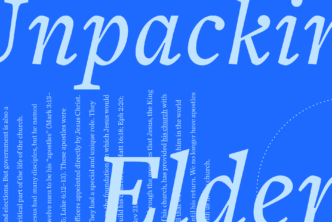I could tell by the faces of my amazing adult Sunday School class, with whom I have such enriching discussions, that what I had just said did not register. I needed to call an audible. It was time to ditch (temporarily) my planned lesson and start a new, impromptu one. My class needed to learn about Hebrew poetic parallelism.
It’s hard to interpret the Old Testament without some knowledge of this ubiquitous literary form. I turned immediately to the Psalms Explorer in Logos to help me teach it.
Many people have seen the cool (and genuinely useful) bubble graph in this tool—the one that helps users find psalms by categories, like genre, structure, author, and theme.
Even savvy Logos users may not know that the Psalms Explorer has another great visual feature helpful for highlighting parallelism in any psalm. It provides a “structural” view that shows off both the macro-level outline and the micro-level parallelism of every psalm in the Psalter.
Here’s Psalm 44, which I taught in church not long ago:

The “versets”—the parallel portions of any given sentence—are marked with letters (ⓐⓑⓒⓓ) to show where the parallelisms are. And in a pop-up window, each parallelism is described with traditional categories:
- Synonymous: lines are equivalent in meaning.
- Antithetic: lines contrast in meaning.
- Synthetic: one line develops or intensifies another.
- Staircase: a portion of one line is repeated verbatim in the next, creating anticipation.
- Emblematic: the meaning of one line is repeated as a metaphor or simile.
The second verse of Psalm 44 is marked as “antithetic” parallelism, because it shows two parallel contrasts. God drove out the nations but planted Israel; he afflicted those nations but set Israel free.

Poetic parallelism is absolutely essential to understanding the Old Testament. Bruce Waltke says in his Proverbs commentary, “As rhyme and meter traditionally characterize English poetry but not Hebrew poetry, so parallelism characterizes Hebrew poetry but not English poetry. Parallelism is its cornerstone for meaning, not merely an adornment.”
Stages of learning
I’m no pedagogy expert, but in my own learning of the features of language, foreign or domestic, I have observed three general stages. First, I half-perceive a thing intuitively (like parallelism). Then, once I learn a label for it (like “antithetic”), I can really see it. And finally, by regular use of the right labels, I pass again into another stage of intuitive understanding. At this final stage I don’t have to make explicit recourse to the labels anymore (surely the original Jewish readers didn’t); I just get it.
I strongly suspect that my Sunday school class was at stage 1: They did perceive the parallelism at some level, but they didn’t know the label for it. They’d half-understood it intuitively, but had never heard anyone describe it. And without the deeper understanding that comes from the label, they could not ascend to the level of a skillful reader of Hebrew poetry.
Insight into Psalm 44
As usual with grammatical labeling, there is some interpretation involved, and you might not always agree with all the labels provided. Even so, the information is helpful. For example, verse 9 is labeled “synonymous”: the two lines are saying the same thing.

Verse 10, meanwhile, is labeled “synthetic,” meaning there’s some advance or development from the first line to the second.

These two labels raised a few questions for me: Why wouldn’t verse 9 be marked as “synthetic”? Doesn’t it show an advance or development? How is verse 9 any more “synonymous” than verse 10?
The answer I arrived at was that the two lines of verse 9 are indeed “synonymous,” in that the second verset shows how the Lord has rejected and disgraced Israel: He did not go out with their armies. These two versets, both marked ⓐ, are not lamenting two things the Lord did to Israel; they’re lamenting just one.
The danger of reaching stage 3 in your reading—the stage of skillful (rather than ignorant) intuition—is that you’ll get lazy and forget to discern the meaning behind the parallelism. In this case, moving back to stage 2 and calling up the labels (“synonymous” and “synthetic”) helped me pay attention to what the psalmist was trying to communicate.
If you are not familiar with poetic parallelism, I know of no other tool that can help you identify it so easily and clearly. The Psalms Explorer and its “structure” view are fantastic aids for learning how to interpret Hebrew poetry, whether it’s in the Psalms, Proverbs, the Prophets, or other Old Testament texts.
Mark L. Ward, Jr. received his PhD from Bob Jones University in 2012; he now serves the church as a Logos Pro. His most recent book is Authorized: The Use and Misuse of the King James Bible (forthcoming, Lexham Press).
Get started with free Bible software
Compare translations, take notes and highlight, consult devotionals and commentaries, look up Greek and Hebrew words, and much more—all with the help of intuitive, interactive tools.
Get the Logos Bible app free today.




